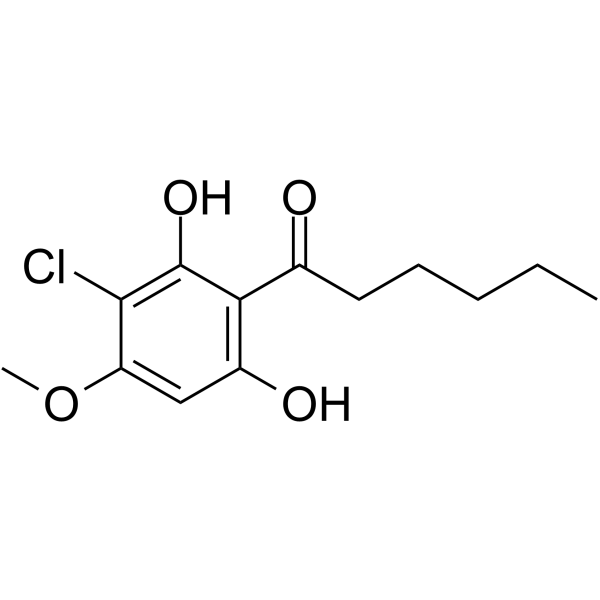DIF-3

DIF-3 structure
|
Common Name | DIF-3 | ||
|---|---|---|---|---|
| CAS Number | 113411-17-9 | Molecular Weight | 272.72500 | |
| Density | 1.24g/cm3 | Boiling Point | 416.9ºC at 760mmHg | |
| Molecular Formula | C13H17ClO4 | Melting Point | N/A | |
| MSDS | Chinese USA | Flash Point | 205.9ºC | |
|
The requirement for DIF for prestalk and stalk cell formation in Dictyostelium discoideum: a comparison of in vivo and in vitro differentiation conditions.
Dev. Biol. 127(2) , 296-303, (1988) In Dictyostelium discoideum stalk cell formation is induced by cyclic AMP and differentiation-inducing factor (DIF) when cells are plated in in vitro monolayers (Kay et al., 1979, Differentiation 13: 7-14). The in vivo developmental stages at which cells beca... |
|
|
Extracellular signals and intracellular transduction pathways regulating Dictyostelium development.
Curr. Opin. Cell Biol. 1(6) , 1132-8, (1989)
|
|
|
Cytoplasmic acidification facilitates but does not mediate DIF-induced prestalk gene expression in Dictyostelium discoideum.
Dev. Biol. 140(1) , 182-8, (1990) Stalk cell differentiation in Dictyostelium can be induced by the differentiation-inducing factor, DIF, or by conditions that decrease intracellular pH (pHi). We have investigated whether cytoplasmic acidification acts directly to induce expression of pDd56 a... |
|
|
Derivatives of Dictyostelium discoideum differentiation-inducing factor-3 suppress the activities of Trypanosoma cruzi in vitro and in vivo.
Biochem. Pharmacol. 85(11) , 1603-10, (2013) Chagas disease (human American trypanosomiasis), which is caused by the protozoan parasite Trypanosoma cruzi, is responsible for numerous deaths each year; however, established treatments for the disease are limited. Differentiation-inducing factor-1 (DIF-1) ... |
|
|
Dictyostelium differentiation-inducing factor-3 activates glycogen synthase kinase-3beta and degrades cyclin D1 in mammalian cells.
J. Biol. Chem. 278(11) , 9663-70, (2003) In search of chemical substances applicable for the treatment of cancer and other proliferative disorders, we studied the signal transduction of Dictyostelium differentiation-inducing factors (DIFs) in mammalian cells mainly using HeLa cells. Although DIF-1 a... |
|
|
Involvement of GSK-3beta and DYRK1B in differentiation-inducing factor-3-induced phosphorylation of cyclin D1 in HeLa cells.
J. Biol. Chem. 281(50) , 38489-97, (2006) Differentiation-inducing factors (DIFs) are putative morphogens that induce cell differentiation in Dictyostelium discoideum. We previously reported that DIF-3 activates glycogen synthase kinase-3beta (GSK-3beta), resulting in the degradation of cyclin D1 in ... |
|
|
The search for morphogens in Dictyostelium.
Bioessays 9(6) , 187-91, (1988)
|
|
|
Differentiation-inducing factor from the slime mould Dictyostelium discoideum and its analogues. Synthesis, structure and biological activity.
Biochem. J. 256(1) , 23-8, (1988) Previous work has led to the identification of a novel class of effector molecules [DIFs (differentiation-inducing factors) 1-3] released from the slime mould Dictyostelium discoideum. These substances induce stalk-cell differentiation in Dictyostelium discoi... |
|
|
Derivatives of Dictyostelium differentiation-inducing factors promote mitogen-activated IL-2 production via AP-1 in Jurkat cells.
Life Sci. 88 , 480-485, (2011) Differentiation-inducing factors (DIFs) are chlorinated alkylphenones found in the cellular slime mold Dictyostelium discoideum. DIF derivatives exhibit antiproliferative activities and promote glucose consumption in mammalian cells in vitro. Here, we assesse... |
|
|
Effects of differentiation-inducing factors of Dictyostelium discoideum on human leukemia K562 cells: DIF-3 is the most potent anti-leukemic agent.
Eur. J. Pharmacol. 381(1) , 57-62, (1999) DIF-1 (differentiation-inducing factor-1; 1-(3,5-dichloro-2, 6-dihydroxy-4-methoxyphenyl)hexan-1-one) is a putative morphogen that induces stalk cell formation in the cellular slime mold, Dictyostelium discoideum. It has been previously reported that DIF-1 ex... |